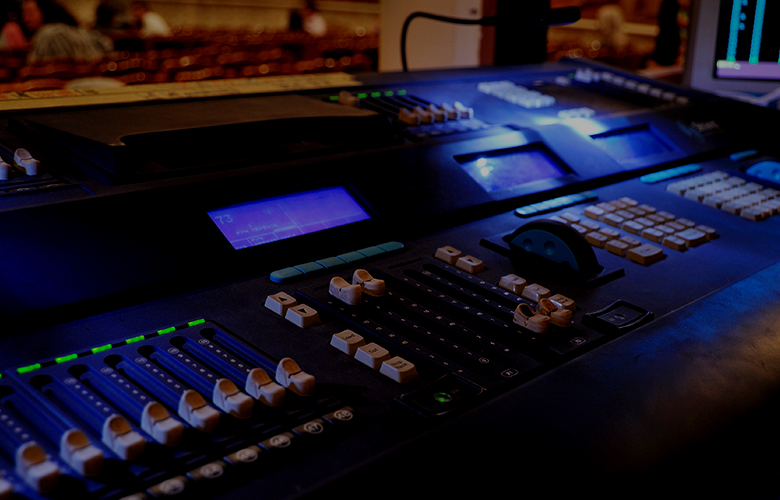
Amidst all the automated lighting fixtures, automated scenery, and every conceivable high-tech toy now available to a modern theatrical production, the lowly tech table has lagged behind in terms of thought, consideration, and design.
As a theatrical lighting designer, I work at a tech table all day, 15 hours a day, six days a week, for at least one to two weeks. Without a doubt, my aching back, shoulders, and neck need help.
I am not alone. A great number of us ignore the physical strain that accumulates while we do such focused, intensive, deadline driven work at the tech table. A lot of musculoskeletal disorders can develop when working in an uncomfortable, static position all day.
Technical rehearsals are when the efforts of the director, choreographer, music director, designers, performers, musicians, dancers and technicians all come together onstage to create the magic of performance. To create a 2 hour 30-minute performance can take one or two weeks (which clocks in at about 90 hours per week) to eight or more weeks for some of the most elaborate productions on Broadway or in Las Vegas.
During those weeks, the tech table is my home base. The work is very intensive, as I imagine, program and trouble shoot lighting cues in real time as the scene is being performed. As in any intensive work, my body tends to freeze in a static position as I focus so fully on the programming tasks at hand.
At its most basic, a tech table can be a single slab of plywood, painted black, thrown over a couple of rows of seats near the rear of the orchestra level. Sometimes, it is a temporary tabletop with supporting legs.
The key to surviving is finding a comfortable seating arrangement that puts me at a reasonable working height and proximity, relative to the table. Ergonomic wisdom says that my forearms should be parallel to the table. My chair should allow me to sit up straight comfortably, centered on my sit bones, with my back supported in a neutral position, so I do not have to lean forward. But this is not always possible.
Auditorium seats are typically too low in height for the creative staff to work comfortably at the tech table, and so far away from the table that I constantly have to lean forward to work.
After a few short hours, my back starts to hurt from leaning forward and nothing that I do at that point can shake the muscle and nerve pain that has set in.
Sometimes a “butt board”— a piece of ¾” thick board, about 12” wide is thrown over the seat armrests, to prop me up higher. Unfortunately, this arrangement leaves me too high and too far away from the tech table, and I still need to lean and hunch forward.
My solution is to find a straight back (non-folding) chair somewhere in the building and scavenge a bed pillow, either from the props department or my hotel. Then I wedge the chair between the tech table and existing auditorium seat. The chair provides a decent working height, relative to the table. The pillow goes behind my back to put me closer to the table and allows me to sit up straight comfortably, with my spine supported and my shoulders relaxed. Much better…
Because my chair is close to the row of seats in front of me, I have to straddle my legs slightly to either side of the seat, which is comfortable for me but may not be for others attempting this approach.
The tech table also needs to overhang sufficiently into the row in which I am seated, so that the table’s leading edge overlaps my lap, similar to being seated at an office desk.
One of my favorite tech tables, created by one lighting department that understood my predicament, solves this issue by including a horizontal sliding track, similar to a sliding drawer mechanism. Once I am seated, I can pull the tabletop towards me, and then push it away from me when I am ready to stand up. There is just the right amount of friction in the sliding track so it stays put once I have pulled it into position, and it takes just a slight motion to push it away when I want to get up.
Each evening back at my hotel, I do stretching exercises to relax and stretch my muscles and work out the kinks from being at the tech table all day.
For years, doing these nightly stretches has allowed me to dispel my daily physical discomfort and continue to work in this profession I so love.
Everyone has their own strategies to manage the physical strain of working at a tech table, usually with less than optimum results. We are just now beginning to become aware the issue as an industry. I look forward to the day that temporary, comfortable tech table and chair arrangements are available to every production, large and small. Our aching bodies will be most grateful.
Also by Dawn Chiang:
Want To Perform In The USA? Here’s How To Get A Visa Now


Dawn Chiang designed the lighting on Broadway for “Zoot Suit”, was co-designer for “Tango Pasion”, and associate lighting designer for “Show Boat”, “The Life” and the original Broadway production of “La Cage Aux Folles”. Dawn was resident lighting designer for New York City Opera. She worked on the concert tours of Paul Anka, The Carpenters, Diana Ross, and Loggins and Messina. She has designed the lighting at numerous regional theaters including Arena Stage, Oregon Shakespeare Festival, Denver Center Theatre Company, Guthrie Theater, Alliance Theatre, and the Mark Taper Forum. Dawn has earned two Drama-Logue Critics' Awards, two Lighting Designer of the Year Awards (Syracuse Area Live Theatre), and nominations for the San Francisco Drama Critics’ Award, Los Angeles Drama Critics’ Award and the Hewes Design Award from American Theatre Wing. She served on the board of directors for Theatre Communications Group, the national service organization for professional non-profit American theatres, and is a mentor for the Theater Development Fund’s “Open Doors” outreach program. Dawn is a senior consultant with Theatre Projects Consultants, where she served as project manager for two of the largest water based permanent shows — “House of Dancing Water” in Macau and the Han Theatre in central China.
Read Full Profile© 2021 TheatreArtLife. All rights reserved.

Thank you so much for reading, but you have now reached your free article limit for this month.
Our contributors are currently writing more articles for you to enjoy.
To keep reading, all you have to do is become a subscriber and then you can read unlimited articles anytime.
Your investment will help us continue to ignite connections across the globe in live entertainment and build this community for industry professionals.